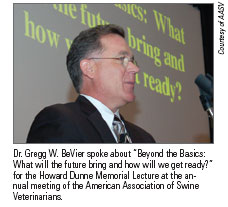Prognostications for swine medicine
|
The focus was on the future at the American Association of Swine Veterinarians' 37th annual meeting, held March 4-7 in Kansas City, Mo.
Forecasting the futureDr. Gregg W. BeVier of Global Agribusiness Partners in Duluth, Ga., gave the Howard Dunne Memorial Lecture. The title was "Beyond the Basics: What will the future bring and how will we get ready?" His main message was that the best way to predict the future is to invent it. Dr. BeVier started by describing global population growth, urbanization, and increasing incomes. These factors drive a demand for more meat, he said. The swine industry will respond by continuing to consolidate, integrate, automate, and "technify" operations to improve productivity. "Veterinary medicine could be much more involved in the food chain, not just on the farm," he added. Dr. BeVier said swine veterinarians could pursue management careers in genetics, animal health, and production. Other opportunities will arise in nutrition, environment, processing, and retail. Practitioners will want to focus even more on preventive medicine, he said, and perhaps developing an index to measure their contributions to swine health. "Really, the most important thing we can do to reinvent ourselves is to go out and push ourselves in new areas," he added. "I think I see a lot of hesitation in a lot of the membership at times to try new things." Perspectives on changeDr. Jim Lowe of The Maschhoffs Inc. in Carlyle, Ill., spoke about the practitioner's perspective on challenges and changes in the swine industry. Dr. Lowe said the North American swine industry is grappling with rising costs and foreign diseases as well as the global market. The industry will turn to automation and information technology for answers, creating a call for "technified" managers. Swine practitioners can respond by learning about communication and leadership along with science and technology, he said. "As veterinarians, we are positioned wonderfully to be great leaders in this industry," he said. Steven Pollmann, PhD, of Murphy-Brown LLC in Ames, Iowa, spoke about the producer's perspective. Dr. Pollmann said changes in the industry include the increase in consolidation and productivity. Challenges include the dependence on exports and a need to modernize facilities. His outlook was for a relatively long period of profit, but he offered some suggestions to practitioners. Dr. Pollmann asked swine veterinarians to refer to research, think about the business, and talk to the employees before taking the "try and see" approach to medicine. "We can no longer have superstars," he said. "We need to have super teams." Gary Louis, PhD, of Seaboard Foods LLC in Shawnee Mission, Kan., spoke about the packer's perspective. The pork of the future will look exactly like the pork of the present, Dr. Louis said, but consumers want more information about what's behind the meat. "Our industry is going to become more transparent," Dr. Louis said. "A lot of us aren't going to like it." He said the information age of pork will focus on traceability, animal welfare, food safety, meat quality, export markets, niche products, and industry integrity. Secrets to survivalDr. Roy A. Schultz concluded the general session with the founder's message, "Successes and failures in swine veterinary medicine—What have we learned?" Dr. Schultz said veterinarians face a severe crisis, but they have survived crises in the past. The first challenge was when automobiles replaced horses, the mainstay of the veterinary profession. For swine practitioners, the second challenge was reinventing themselves after eradicating hog cholera, also known as classical swine fever. Dr. Schultz said the current crisis for swine veterinarians is the consolidation of the industry because they are struggling to adapt to the needs of corporate producers. "I think in a lot of large organizations, the veterinarian is the scapegoat," he said. But the secrets to survival remain the same, Dr. Schultz said. Veterinarians need to be able to adapt, collaborate, and learn throughout their lifetime.
| ||
 During the general session, members took a look at how globalization and technology will shape the swine industry and swine medicine in years to come. At a variety of other sessions, members tackled more immediate issues ranging from infectious diseases to consumer concerns and beyond. Throughout the meeting, they also welcomed veterinary students—the next generation of AASV membership.
During the general session, members took a look at how globalization and technology will shape the swine industry and swine medicine in years to come. At a variety of other sessions, members tackled more immediate issues ranging from infectious diseases to consumer concerns and beyond. Throughout the meeting, they also welcomed veterinary students—the next generation of AASV membership.  Beyond the general session
Beyond the general session